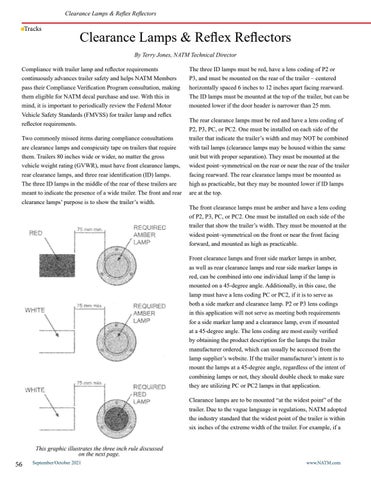Clearance Lamps & Reflex Reflectors
Tracks
Clearance Lamps & Reflex Reflectors By Terry Jones, NATM Technical Director
Compliance with trailer lamp and reflector requirements continuously advances trailer safety and helps NATM Members pass their Compliance Verification Program consultation, making them eligible for NATM decal purchase and use. With this in mind, it is important to periodically review the Federal Motor Vehicle Safety Standards (FMVSS) for trailer lamp and reflex reflector requirements. Two commonly missed items during compliance consultations are clearance lamps and conspicuity tape on trailers that require them. Trailers 80 inches wide or wider, no matter the gross vehicle weight rating (GVWR), must have front clearance lamps, rear clearance lamps, and three rear identification (ID) lamps. The three ID lamps in the middle of the rear of these trailers are meant to indicate the presence of a wide trailer. The front and rear clearance lamps’ purpose is to show the trailer’s width.
The three ID lamps must be red, have a lens coding of P2 or P3, and must be mounted on the rear of the trailer – centered horizontally spaced 6 inches to 12 inches apart facing rearward. The ID lamps must be mounted at the top of the trailer, but can be mounted lower if the door header is narrower than 25 mm. The rear clearance lamps must be red and have a lens coding of P2, P3, PC, or PC2. One must be installed on each side of the trailer that indicate the trailer’s width and may NOT be combined with tail lamps (clearance lamps may be housed within the same unit but with proper separation). They must be mounted at the widest point–symmetrical on the rear or near the rear of the trailer facing rearward. The rear clearance lamps must be mounted as high as practicable, but they may be mounted lower if ID lamps are at the top. The front clearance lamps must be amber and have a lens coding of P2, P3, PC, or PC2. One must be installed on each side of the trailer that show the trailer’s width. They must be mounted at the widest point–symmetrical on the front or near the front facing forward, and mounted as high as practicable. Front clearance lamps and front side marker lamps in amber, as well as rear clearance lamps and rear side marker lamps in red, can be combined into one individual lamp if the lamp is mounted on a 45-degree angle. Additionally, in this case, the lamp must have a lens coding PC or PC2, if it is to serve as both a side marker and clearance lamp. P2 or P3 lens codings in this application will not serve as meeting both requirements for a side marker lamp and a clearance lamp, even if mounted at a 45-degree angle. The lens coding are most easily verified by obtaining the product description for the lamps the trailer manufacturer ordered, which can usually be accessed from the lamp supplier’s website. If the trailer manufacturer’s intent is to mount the lamps at a 45-degree angle, regardless of the intent of combining lamps or not, they should double check to make sure they are utilizing PC or PC2 lamps in that application. Clearance lamps are to be mounted “at the widest point” of the trailer. Due to the vague language in regulations, NATM adopted the industry standard that the widest point of the trailer is within six inches of the extreme width of the trailer. For example, if a
This graphic illustrates the three inch rule discussed on the next page.
56
September/October 2021
www.NATM.com


































